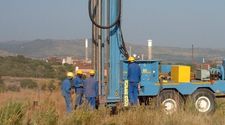
Many countries have disused sealed radioactive sources (DSRS) from medical and industrial use that are small in size but present a potentially significant radiological hazard. For more than two decades, Quintessa has been providing support to an International Atomic Energy Agency (IAEA) initiative to develop and implement a safe and secure borehole disposal route for these wastes using the borehole disposal concept (BDC).
In particular, Quintessa has taken the lead in developing a generic post-closure radiological safety assessment (GSA) for the BDC. The ISAM safety assessment approach has been used, with the aim of ensuring that the assessment is undertaken and documented in a consistent, logical and transparent manner. The GSA highlights the concept’s key safety features, under varying disposal system conditions, and supports the concept design and licensing processes. Integral to this work has been the application of Quintessa’s compartmental modelling tool, AMBER to implement the conceptual and mathematical models described in the GSA. In turn, the GSA has been used as a starting point for the development of site-specific safety assessments in a number of countries, such as Malaysia and Ghana, to support the associated design and licensing processes. This has involved the provision of guidance and support by Quintessa staff through hosting and providing safety assessment and software training; undertaking expert missions to the countries, and providing peer review and advice.

In addition, Quintessa has contributed to the IAEA study of the application of the graded approach to the post-closure safety assessment for the disposal of DSRS in boreholes. This has included the development and application of the BDC Scoping Tool which allows the containment provided by the BDC’s capsule and disposal container in the post-closure period to be evaluated. The tool allows rapid decision making by providing an early indication of the potential suitability of sites based on their hydro-chemical characteristics.

User interface of the BDC Scoping Tool.